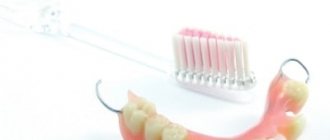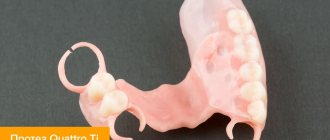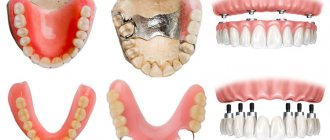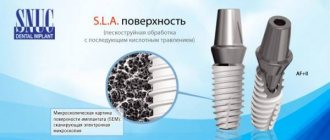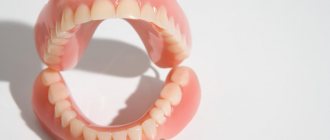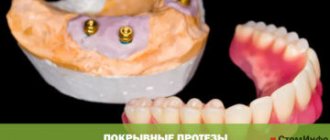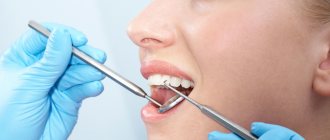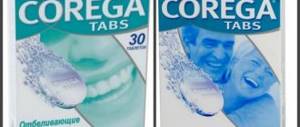In case of multiple restoration of lost teeth, one of the best solutions is the installation of a prosthesis supported by implants. Today, there are many techniques and technologies on the market designed to solve problems in almost all clinical cases. In case of complete absence of teeth, one of the options is a removable denture on implants. Find out more in an interview with Startsmile with orthopedic dentist at the Smile-at-Once innovative technologies clinic in Moscow, Yuri Vasin.
Removable dentures: the fastest and cheapest way to replace teeth
Removable dentures are products with a soft or hard base that imitates the mucous membrane of the oral cavity, and artificial teeth. They can be partial or complete, that is, replace a segment of the dentition or the entire jaw. A partial removable denture has special hooks - metal made of clasp wire (clasp-based denture) or plastic, which cling to the teeth, and a complete removable denture is fixed in the oral cavity due to the valve zone.
It is believed that removable dentures are now hopelessly outdated, but they have their advantages, thanks to which this solution is still in demand.
A)
Perhaps their most important advantage is the price. The cost of a removable denture depends on the material and the number of teeth being restored, however, even the most expensive removable denture costs several times less than a similar design on implants.
b)
Typically, such prostheses are manufactured within 2 weeks and do not require surgical intervention, unlike implantation. It is no secret that most patients try to avoid any surgical interventions and often choose removable dentures for this very reason.
c)
If 40-50 years ago removable dentures did not look very natural, then modern solutions (silicone removable dentures, orthopedic structures using composite teeth and individual options for coloring the base of a removable denture) can satisfy even the most demanding patient.
Ball-shaped implant mounting system
Special abutments are placed on the tops of the implants, which look like a ball from above - this is a spherical mount. Metal fasteners are installed in the inner part of the prosthetic base (their number is equal to the number of implants), and each fastener also has a rubber or silicone ring to hold the spherical part of the abutment.
The prosthesis snaps onto spherical aba) and is easily removed at home. But, despite the ease of installation/removal and low cost, such fasteners last a maximum of 2-3 years, because the balls wear off on the sides, become flat, and the prosthesis begins to wobble and fall out. And before implantation, check with your doctor whether the selected abutments can be replaced or not, otherwise there is a risk of their removal along with the implants.
Disadvantages of removable dentures
- With functionality and convenience, things are much worse. If we take the entire row of natural teeth to be 100% efficient at chewing food, then a complete removable denture (due to its design features) will allow us to achieve only 30% of the maximum capabilities.
- Another big problem with a complete removable plate denture is the unsatisfactory fixation of the prosthesis in the oral cavity. Even a properly made complete removable plate denture will not always stay well in the mouth when speaking and chewing. Also, such a prosthesis can lead to impaired diction and overlap of tactile and temperature receptors.
- A removable denture requires constant and regular correction. Food getting under the denture, the need for constant cleaning and treatment, the sensation of a foreign body in the oral cavity - this is not a complete list of problems that arise in patients who choose removable dentures.
- It is important to understand that any removable dentures without implants will not stop the process of bone tissue atrophy, which inevitably occurs after the loss of a natural tooth. Only an implantation procedure can stop bone loss.
Main stages of prosthetics
Prosthetics is carried out in 6 main stages:
- Examination, external examination and examination of the oral cavity, production of diagnostic plaster models, radiological research methods (OPTG, CT, MRI, TRG, etc.), assessment of the function of the dental system (ROM analysis, axiography, electromyography, etc.), diagnosis, selection of orthopedic structures.
- Modeling a wax reproduction of future structures (wax-up), their transfer into the oral cavity (mock-up), assessment of the shape of future restorations, choice of color, assessment of occlusal relationships.
- Preparation of teeth for prosthetics, restoration of core parts of teeth, preparation for future structures.
- Determination of the optimal position of the lower jaw and the height of the lower part of the face.
- Manufacturing of orthopedic restorations and their fixation in the oral cavity.
- Dispensary examination once every six months.
Please note that depending on the choice of orthopedic structures, treatment tactics and its stages may change.
Possibilities of a conditionally removable denture supported by natural teeth
A fixed bridge supported by your own teeth will help replace 1 to 4 missing teeth in a row. The undoubted advantage of such dentures is a better restoration of chewing function compared to removable dentures, the absence of discomfort and good aesthetic characteristics. Bridges do not need to be maintained or adjusted: up to a certain point, the patient may not notice them at all. Of course, this design will also cost significantly less than an implant-supported prosthesis. But there are some nuances here too.
✔
With a classic bridge, only a few teeth can be restored, because the supporting teeth also need to be taken into account. For example, to replace 1 tooth, the patient is given a prosthesis on 2 supporting teeth.
✔
Abutment teeth (even completely healthy ones) must be ground down for crowns.
✔
In this case, the tissues surrounding the tooth, the so-called periodontium, have an increased chewing function, taking on the load of the missing tooth. Over a long period of operation, the reserve forces of the periodontium of the supporting teeth will weaken, which, as a consequence, sooner or later will lead to their loss. That is why the service life of bridges, as a rule, does not exceed 7-10 years.
How does the procedure work?
Attachment of microprostheses occurs as follows:
- metal paws in the teeth, localizing the defect. Form grooves where the prosthesis is attached;
- special cement. The micromodule is fixed on adjacent incisors using a solution that is polymized under the influence of ultraviolet radiation and chemically;
- micro locks. The matrices are attached to adjacent teeth or crowns standing on them.
The last two methods make structures invisible to humans and others.
Why is implant-supported prosthesis considered the best solution?
I.
The dental implant method allows you to restore lost teeth using single crowns, bridges and full dentures supported by implants. Such a prosthesis, even in the absence of all teeth, completely restores chewing function.
II.
The implant completely replaces the root of a natural tooth: it receives the load from the crown and distributes it to the bone tissue, so that it does not undergo atrophy. Simply put, with the help of dental implants, the doctor restores the natural function of chewing to the fullest extent possible. Feedback from patients about implantation, especially from those who have previously used prostheses of other designs, will be positive in the vast majority of cases.
III.
The service life of an intraosseous dental implant (if its installation was carried out efficiently) is practically unlimited. We see patients who had implants installed more than 30 years ago. Particular attention should be paid to self-discipline and compliance with all rules of oral hygiene. The patient must understand that the presence of implants increases the requirements for daily hygiene (using not only a toothbrush, but also an irrigator) and implies regular (2 times a year) professional oral hygiene. Thus, the long-term functioning of implants is not only the competent work of the doctor, but also the responsible attitude of the patient himself to his health.
Mounting on equatorial type abutments (Locator)
The equatorial fastening is also of the push-button type, only here the top of the abutment is presented not in the form of a ball, but in the form of a cylinder. The development of equator attachments belongs to Straumann, one of the three leaders in the implantation industry. The original “locators” are made of the strongest titanium and do not break or wear out under load. Therefore, they do not need such targeted observation as spherical ones (i.e., you will need to visit the dentist less often). In general, the equator type is superior to spherical abutments in terms of quality of fixation, wearing comfort and service life, but, accordingly, it is more expensive.
How many implants are needed to install a prosthesis?
➢
Restoration of several teeth. It is optimal when implants replace every lost tooth. If 3 teeth are missing, we install 3 implants and replace each implant with a separate crown. We get maximum and natural restoration of chewing function and the best aesthetic result. It is possible to install 2 implants when replacing 3 lost teeth - this is already a bridge prosthesis. The chewing function is restored completely, but restoration of ideal aesthetic parameters can be difficult, as well as hygiene.
➢
Restoration of a completely toothless jaw
- Conditionally removable and removable dentures on implants.
When rehabilitating patients with complete edentia, it is not always possible to make a fixed dental prosthesis supported by implants. With prolonged absence of teeth and when using complete removable dentures, atrophy of the alveolar process and narrowing of the dentition occur. In the absence of the required volume of bone tissue and mucous membrane of the alveolar process, especially in the lateral parts of the jaws, implants as a support for a conditionally removable denture can be installed in the front part of the jaw. The base of such a prosthesis can imitate part of the mucous membrane, which creates an additional cosmetic effect. There are different types of fixation of conditionally removable plate prostheses supported by implants: a beam fixation system, fixation of the prosthesis on ball-shaped abutments, a telescopic system, etc. - Fixed dentures on implants.
If there is a sufficient volume of bone tissue or if teeth are removed simultaneously with the installation of implants, it is possible to manufacture permanent structures on implants. These types of dentures have all the advantages over removable and conditionally removable dentures supported by implants.
- There is no need to remove the denture from the mouth after each meal.
- Reliable fixation of crowns in the oral cavity.
- The shape and size of crowns follow the anatomical shape and size of their teeth. In this case, the chewing load is evenly transferred to the bone tissue surrounding the implants, which allows 100% of the chewing function to be restored. All this makes implant-supported fixed prostheses comfortable and convenient for the patient, so adaptation to such designs occurs as quickly as possible.
In case of complete loss of teeth, prosthetics on dental implants can be carried out in different options.
- “All on 4” is the most gentle technique with the installation of 4 implants and fixation of a fixed prosthesis on them. Surgical intervention in this case is minimal and is carried out using a special surgical template through a puncture of the mucous membrane in the area where the implant is installed.
- Installation of 6-8 implants and subsequent prosthetics with a fixed prosthesis made of metal ceramics and zirconium dioxide.
- Installation of 8 or more implants and fixation of fixed bridges or single crowns made of metal ceramics or zirconium dioxide on them. Today, dentistry has entered the age of digital technology and computerization. Advanced CAD/CAM systems allow you to achieve maximum speed and accuracy in the manufacture of implant-supported orthopedic structures.
Compromises in the cost of final treatment include the choice of the option of fixed prosthetics on implants made of different materials: this is the production of metal-ceramic structures, zirconium with veneer and all-zirconium structures.
To reduce the patient’s financial costs for the manufacture of implant-supported fixed dentures for a toothless jaw, you can consider the concept of patient rehabilitation “All on 4” and “All on 6”, as well as a shortened dentition.
About the disadvantages of implantation
From the outside, implantation may seem like an ideal technique, and in many ways it is - with the exception of a few points. The disadvantage of implantation is not only the high price, but also limitations during the procedure. There are a number of contraindications in the presence of which dental implantation is not recommended or cannot be carried out in principle. In case of absolute contraindications, alternative methods remain the only option.
If a sufficient volume of bone tissue is preserved, prosthetics on dental implants does not present any difficulties and allows the patient to obtain the maximum expected functional result and better aesthetics.
In cases where the volume of bone tissue does not allow the installation of an implant, additional osteoplastic operations are required to restore it. In some cases, plastic surgery of the gingival margin may be required, especially if the patient has high aesthetic needs. In the postoperative period, soft tissue swelling and pain are possible.
If treatment is carried out according to the classic two-stage protocol, the implant is installed in the bone tissue, and sutures are placed on the mucous membrane above it. After surgery, the healing process (waiting for the implant to integrate into the bone) can take from several weeks to several months. Then the second stage, additional surgery, is performed. The implant is opened, the external parts are fixed on it, and the orthopedic stage of treatment begins, the manufacture of the actual dentures. Not everyone is ready to wait that long.
There are options for installing an implant during tooth extraction and immediate fixation of a temporary prosthesis on the installed implant. The choice of technique is made by the doctor, based on each specific case.
Prosthetics with fixed structures
Fixed structures:
- Crowns (on teeth or on implants)
- Bridges
- Ceramic inlays
- Veneers
Artificial crowns allow you to restore the integrity of a tooth when it is more than half destroyed. Based on the structural material, metal-ceramic, all-ceramic and zirconium crowns are distinguished. All of them can be made for both teeth and implants.
Crowns
- Metal-ceramic is a budget option for prosthetics, inferior in aesthetics to analogues, and also requiring the preparation of a large amount of tooth tissue for it. All-ceramic and zirconium - they allow a more gentle (minimally invasive) treatment (preparation) of the tooth for installation, they are more aesthetic compared to metal-ceramics, but their price is also higher because of this.
Bridges
- A good choice if one or two teeth are missing in the dentition. Recommended in cases where implantation is impossible or undesirable. The downside is that the bridge structure requires processing (turning) of the supporting teeth (adjacent to the defect).
Ceramic inlays
- Microprostheses are made in cases where the tooth has an extensive carious cavity or an unsatisfactory composite restoration that requires replacement. They have a number of advantages over fillings: inlays do not shrink, which means secondary caries does not form under them, they are durable, distribute the chewing load over the entire surface of the tooth, are aesthetic and do not change their shape over time.
Veneers
- One of the best ways to create an ideal smile when the integrity of the tissues of the teeth (usually the front ones) is damaged, their color, size and shape. They are ceramic overlays on the front surface of the tooth and allow you to change the shape, size and color of the teeth, ideally hiding cracks, chips, and darkening of the tooth. Veneers are used for the restoration of front teeth.
Diagnostics is the first and key step in dental prosthetics. Do you want to know why it’s impossible to do without diagnostics?
About implant brands and price differences
The most expensive implants are those made in Europe and the USA, but this does not mean that they have no alternative. We recommend paying attention to South Korean implants. Many are quite skeptical about products from Asia, but the medical industry of South Korea is not inferior to leading Western countries in terms of technological solutions. One of the best South Korean implant systems is Osstem. The company offers a wide range of implants and abutments that can solve the problem of partial and complete tooth loss in patients of various age and social groups. The possibility of 3D planning and the availability of special sets of tools for installing Osstem implants in conditions of bone deficiency makes it universal.
It is very important that the selected company producing implants has a distributor in your city who would not only sell this system, but also conduct courses, seminars, master classes and provide all the necessary technical support to doctors and patients. There is no need to save on your health by trusting systems that have not received a license and do not have official representation in Russia.
Selection rules
When choosing the type of connecting element, the specialist and the patient are guided by a number of rules:
- Clinical picture. Here it is important to take into account the parameters of the implant, the volume and height of the periodontal soft tissues, the distance between the titanium rods, and the location of the implant in hard structures.
- Method of fixing the connecting link.
- The total cost of mini prosthetics.
In general, modern implantation systems are ready to provide enough models of abutments with a round tip for various clinical situations.
The role of the doctor in choosing a treatment method
Often, already at the first consultation, the patient categorically declares: “I need an implant!” It sounds so confident that it seems that only the lack of appropriate tools is keeping the patient from doing it himself.
Before receiving the right to treat patients, a doctor studies for 6 years, then for 2 years he can undergo highly specialized training. Every 5 years he goes to improve his qualifications, but in fact he studies all his life, constantly gaining new experience, skills and knowledge. What can be concluded? Only a doctor can draw up an optimal rehabilitation plan and carry out the necessary manipulations.
Before starting treatment, a comprehensive clinical and radiological examination is carried out, and if necessary, the patient is referred for consultations to doctors of related specialties. Not only the extent of the dental defect is assessed, but also the condition of each remaining tooth, the quantity and quality of bone tissue, and the presence and severity of the patient’s general diseases. Only then will it be possible to make a diagnosis and formulate a treatment plan. Of course, the patient should be fully informed about both the treatment plan and alternative methods.
In conclusion, we would like to advise patients who have not decided on the choice of treatment method and who have no serious contraindications to pay attention to dental implants.
